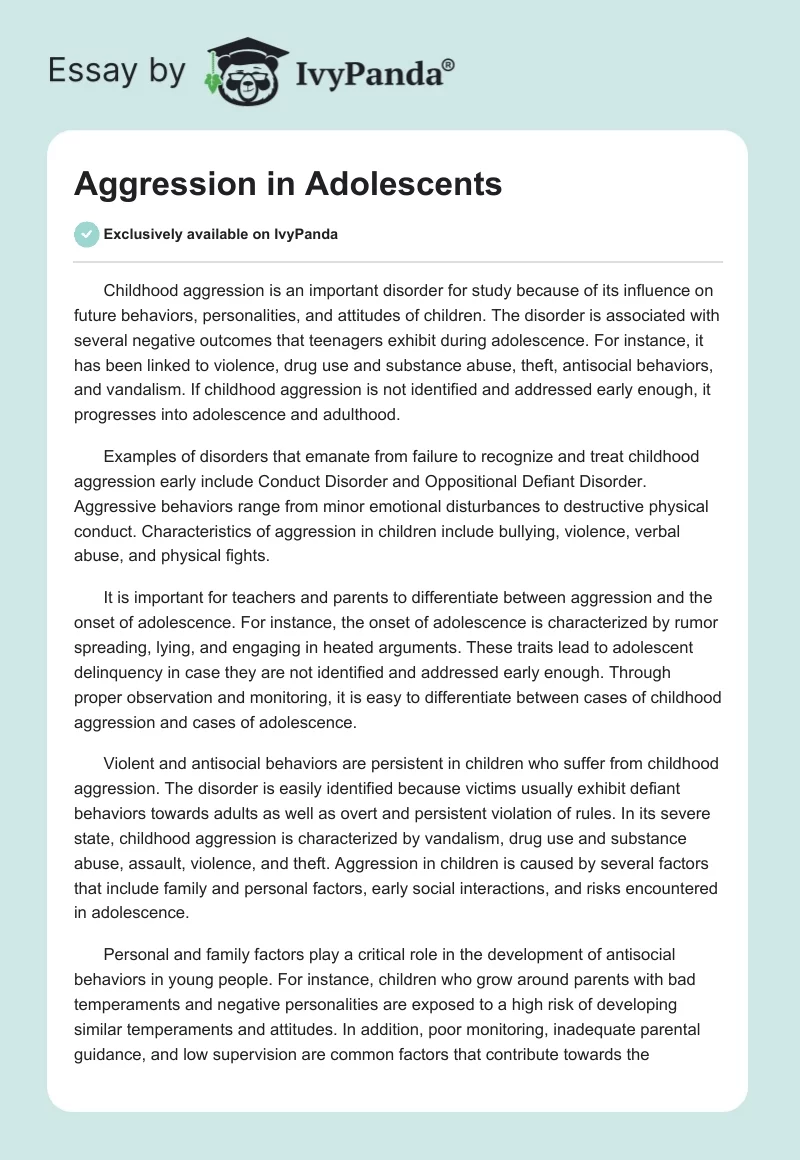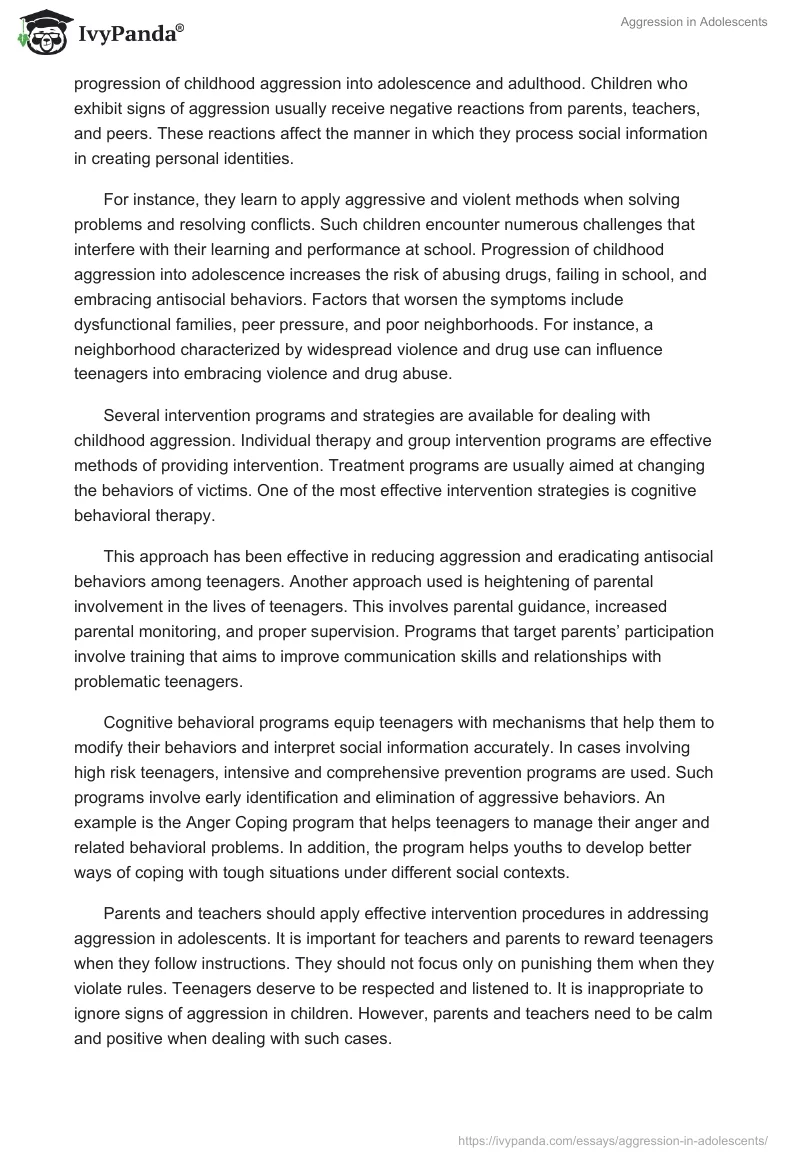Childhood aggression is an important disorder for study because of its influence on future behaviors, personalities, and attitudes of children. The disorder is associated with several negative outcomes that teenagers exhibit during adolescence. For instance, it has been linked to violence, drug use and substance abuse, theft, antisocial behaviors, and vandalism. If childhood aggression is not identified and addressed early enough, it progresses into adolescence and adulthood.
Examples of disorders that emanate from failure to recognize and treat childhood aggression early include Conduct Disorder and Oppositional Defiant Disorder. Aggressive behaviors range from minor emotional disturbances to destructive physical conduct. Characteristics of aggression in children include bullying, violence, verbal abuse, and physical fights.
It is important for teachers and parents to differentiate between aggression and the onset of adolescence. For instance, the onset of adolescence is characterized by rumor spreading, lying, and engaging in heated arguments. These traits lead to adolescent delinquency in case they are not identified and addressed early enough. Through proper observation and monitoring, it is easy to differentiate between cases of childhood aggression and cases of adolescence.
Violent and antisocial behaviors are persistent in children who suffer from childhood aggression. The disorder is easily identified because victims usually exhibit defiant behaviors towards adults as well as overt and persistent violation of rules. In its severe state, childhood aggression is characterized by vandalism, drug use and substance abuse, assault, violence, and theft. Aggression in children is caused by several factors that include family and personal factors, early social interactions, and risks encountered in adolescence.
Personal and family factors play a critical role in the development of antisocial behaviors in young people. For instance, children who grow around parents with bad temperaments and negative personalities are exposed to a high risk of developing similar temperaments and attitudes. In addition, poor monitoring, inadequate parental guidance, and low supervision are common factors that contribute towards the progression of childhood aggression into adolescence and adulthood. Children who exhibit signs of aggression usually receive negative reactions from parents, teachers, and peers. These reactions affect the manner in which they process social information in creating personal identities.
For instance, they learn to apply aggressive and violent methods when solving problems and resolving conflicts. Such children encounter numerous challenges that interfere with their learning and performance at school. Progression of childhood aggression into adolescence increases the risk of abusing drugs, failing in school, and embracing antisocial behaviors. Factors that worsen the symptoms include dysfunctional families, peer pressure, and poor neighborhoods. For instance, a neighborhood characterized by widespread violence and drug use can influence teenagers into embracing violence and drug abuse.
Several intervention programs and strategies are available for dealing with childhood aggression. Individual therapy and group intervention programs are effective methods of providing intervention. Treatment programs are usually aimed at changing the behaviors of victims. One of the most effective intervention strategies is cognitive behavioral therapy.
This approach has been effective in reducing aggression and eradicating antisocial behaviors among teenagers. Another approach used is heightening of parental involvement in the lives of teenagers. This involves parental guidance, increased parental monitoring, and proper supervision. Programs that target parents’ participation involve training that aims to improve communication skills and relationships with problematic teenagers.
Cognitive behavioral programs equip teenagers with mechanisms that help them to modify their behaviors and interpret social information accurately. In cases involving high risk teenagers, intensive and comprehensive prevention programs are used. Such programs involve early identification and elimination of aggressive behaviors. An example is the Anger Coping program that helps teenagers to manage their anger and related behavioral problems. In addition, the program helps youths to develop better ways of coping with tough situations under different social contexts.
Parents and teachers should apply effective intervention procedures in addressing aggression in adolescents. It is important for teachers and parents to reward teenagers when they follow instructions. They should not focus only on punishing them when they violate rules. Teenagers deserve to be respected and listened to. It is inappropriate to ignore signs of aggression in children. However, parents and teachers need to be calm and positive when dealing with such cases.
Teenagers need love, care, and attention especially if they are going through tough times. Another tip for dealing with aggressive teenagers is developing effective commands and behavior contracts. Punishment and reward should be balanced. Punishment should follow violation of rules and commands while reward should follow adherence to rules and behavior contracts. Communicating regularly with teenagers is an effective method of identifying problems and dealing with them before they progress to perilous levels.
Parents should follow proper problem solving channels that will make teenagers feel cared for and loved. For instance, punishment should be awarded from the perspective of modifying behavior and not from the perspective of payback for wrongdoing. Finally, teenagers should be taught numerous relaxation techniques to use when faced by situations that cause agitation and anger. In addition, they should be taught how to negotiate with peers and think critically.


